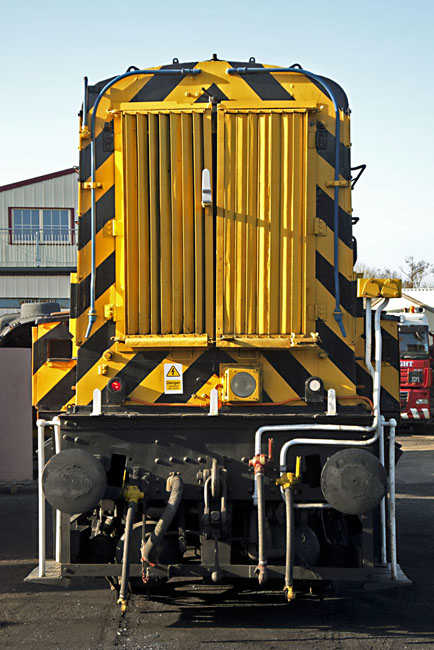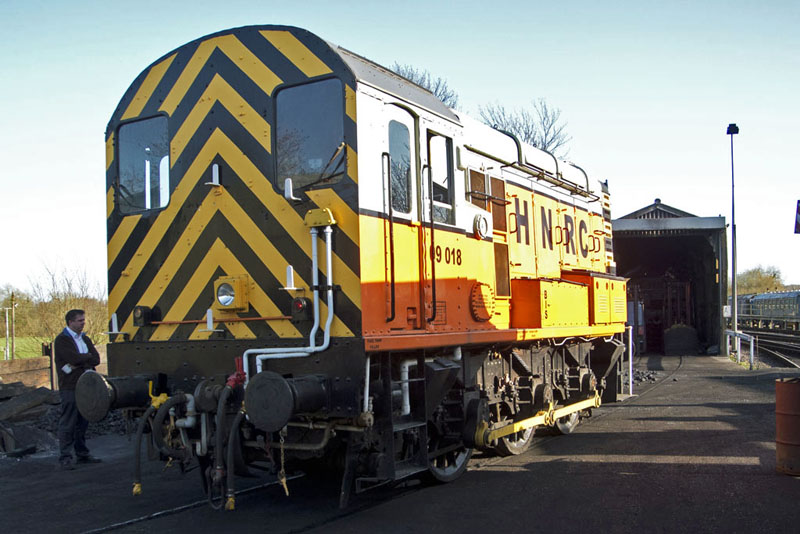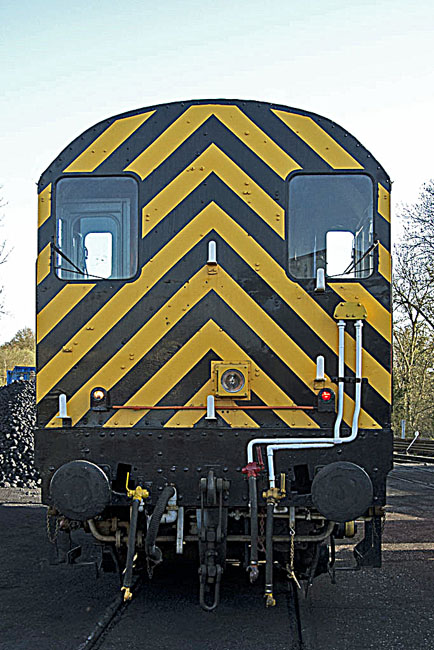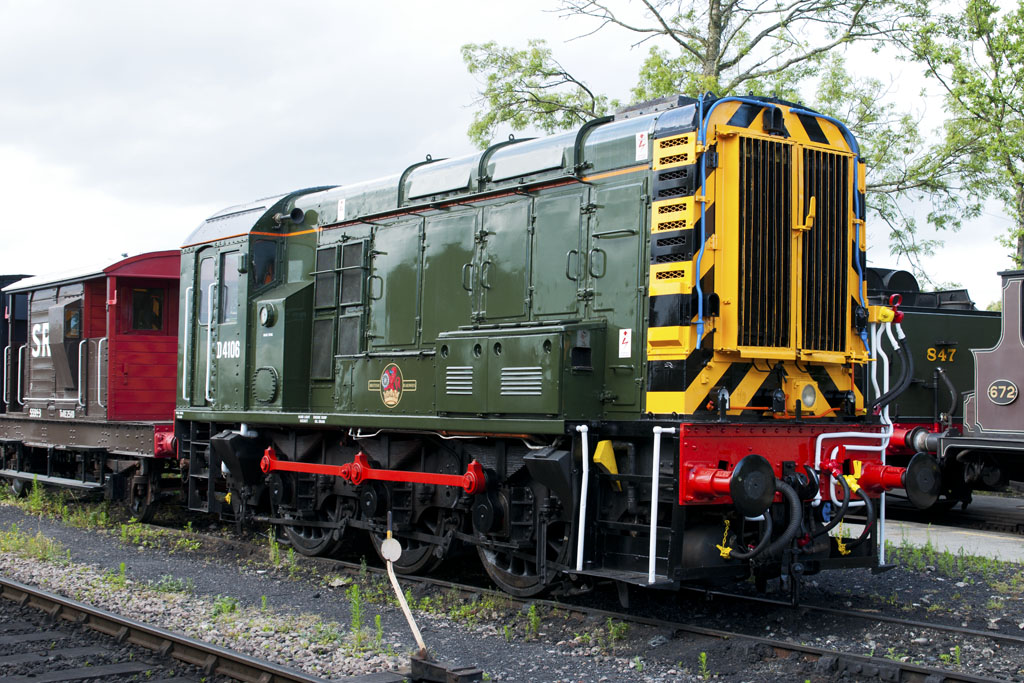

|


|

|
|
Locomotives - Operational Locos - Locos under overhaul - Locos on static display - Locos formerly based on the Bluebell Loco Roster - Loco Stock List - Loco Works News - Join the Loco Dept 

British Railways 350hp diesel-electric shunter D4106D4106 at Sheffield Park in June 2017 following its recent repaint. Diesel-electric shunting loco No.09018 was purchased by a consortium of Loco. Dept. members who have set up a company to manage the loco, which is hired by Bluebell Railway plc. Locomotive No.13236 was returned to its owners once 09018 was commissioned into service. The 350hp diesel-electric shunter had been in development before WW2. The English Electric Co. had been working in cooperation with the pre-Nationalisation railway companies and had built prototypes with all four of them. The LMSR was most interested in the diesel shunter and, in fact, had a strong interest in diesel traction overall. The great advantage of the diesel shunter was that it could work constantly between refuellings and maintenance and thus could replace up to three steam shunting locomotives in a marshalling yard. When fitted with a "deadman's treadle", which applied the brakes in the event of a driver being disabled, it could be operated by a driver alone, without the need for a fireman/secondman. The BR 350hp shunter was developed from a similar LMS machine, the first example appearing in 1952. Subsequent builds included locos with different engines and some with a higher maximum speed, like D4106. Built at BR's Horwich Works and released to traffic on 13 November 1961, D4106 was first allocated to Carlisle Kingmoor (BR/LMS shed code 12A). Its higher speed of 27.5 mph (over the standard 15 mph) gave it an improved performance when undertaking trip working, while not detracting from its ability to undertake general shunting duties, including pushing rafts of wagons over the hump in modern marshalling yards like Kingmoor. To provide the high tractive effort the two traction motors have double-reduction gearing, each having an idler shaft linking the two gear-cases either end of the motor. These gears/pinions are permanently engaged but can be de-meshed to allow the loco to be hauled dead in a goods train. The cab has two driving positions, either side of the control "desk". There are mechanically linked power, reversing and train brake handles on the desk with the loco straight air brake handles being mounted on the front wall of the cab. The speedometer and ammeter are mounted in a housing which can be swung to face either side of the desk. To place D4106 in terms of steam heritage, the notes of a trainspotter visiting Kingmoor shed in 1962 show the loco in company with steam locomotives including Jubilees, Black Fives, Crabs, Coronations, Clans, a Royal Scot and a Britannia, plus several Peak diesels 
On 20th April 1963 D4106 was reallocated to Rugby (2A). Published notes show it reallocated to Crewe (5A) on 20th July 1968, but this probably means that it was sent to Crewe Works for overhaul, as air train brakes were noted as being fitted to it in August 1968. On 10th August 1968 it was allocated to Toton (16A), but then made its way around 23rd September 1968 to Selhurst (75C, the old Norwood Junction shed code). These were the days when everything moved by rail. 350hp diesel-electric shunters could be included in a train if the motors were de-meshed; i.e. if the motor armature did not turn when the wheels rotated. Due to the gearing, the motor armature would be rotating at very high speed even when travelling at 27.5 mph. Excessive speed would ultimately cause the banding on the armature to burst and the motor to be internally destroyed! From Selhurst (whose duties covered New Cross Gate, Redhill, Three Bridges, Horsham and Brighton) D4106 was reallocated to Feltham (70B) on 10th February 1969 and to Ashford (73F) on 6th March 1969. Duties of locos based at Ashford included shunting in Chart Leacon Depot (where they were subsequently based), Ashford Works, Ashford CCE Pre-Assembly Depot, Dover Docks, Faversham, Shepherdswell, Folkestone, Ramsgate, Margate, Paddock Wood and Tonbridge. D4106 was renumbered 09018 on 1st January 1973. Despite the introduction of the air-braked Speedlink service, the 1980s saw a continued decline in wagon-load freight and, consequently, in the need to undertake re-marshalling of trains. In the run-up to privatisation, many rationalisations were made in the rail business. Traffic yards, Civil Engineers' Pre-assembly depots and engineering workshops were closed and the requirement for shunting locomotives was further reduced. Prior to the privatisation of the railways, ownership of 09018 passed to Trainload Freight South-East, which became Mainline Freight. The loco was repainted in the new livery. The three BR trainload freight companies were taken over by EWSR (English, Welsh and Scottish Railways), a subsidiary of US-based Wisconsin Rail. The loco was repainted in EWSR livery during repairs at Hither Green in May 1999. However by 2004 it was stored at Hither Green TMD. On 28th June 2007 EWSR was acquired by Deutsche Bahn AG, which adopted the DB Schenker brand name in 2009. 09018 was offered for sale in April 2010 and was sold to Harry Needle Railroad Company (HNRC) in July. It was moved by road to Boden Rail at Washwood Heath for repairs, which were completed in February 2011, the loco being outshopped in HNRC's orange and grey livery. In October 2011 the loco was moved to the Old Dalby test centre at Ashfordby, allegedly on a four-year contract. However in June 2012 it was moved to the Lafarge works in Hope, Derbyshire from where it was sold by HNRC to a group of Bluebell Railway Locomotive Dept. members, 09018 arriving by road at Sheffield Park on 23rd April 2013. 
09018 just after delivery at Sheffield Park. Trevor West, a member of the owning group, looks on. Ahead of the cab is one of the two main fuel tanks; the engine is gravity fed from a smaller high-level tank which had to be topped up by hand (now electric) pump by the driver at the start of each shift. In front of the fuel tanks is the electrical equipment room containing the generators and traction motor blower etc. The batteries are mounted on both running plates ahead of this, with the exhausters towards the front of the loco. A 15 cu. ft. per min. compressor is mounted underneath. In December 2015 the loco was taken by road to Bombardier's Ilford Depot where its wheels were reprofiled on a ground lathe in order to remove old (pre-Bluebell service) wheel flats. During April/May 2017 the loco was repainted into BR green and renumbered D4106, the work being carried out by Heritage Painting in the workshop at Sheffield Park. The owning group are presently refitting original-style marker lights to the front and rear of the loco. 


Return to BRPS Home Page, to the Timetable or to Special Events Locos Intro - Operational Locos - Locos under overhaul - Locos on static display - Locos formerly based on the Bluebell Loco Roster - Loco Stock List - Loco Works News - Join the Loco Dept Visitor Info. - Museum - Trust - Catering - Contacts - What's New - Projects - Locos - Carriages & Wagons - Signals - History - Other - Links - Search - FAQ Why not become a BRPS Member? - Get more involved as a Volunteer Last updated 27 June 2017 by Jon Elphick and by Richard Salmon, 21 January 2022 © Copyright BRPS. Privacy Policy |
